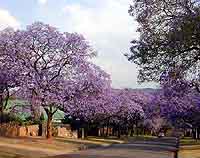View crop
View crop Data sheet EcoPortJacaranda mimosifolia
 |
|
| Notes |
|---|
| DESCRIPTION: A deciduous tree up to 10-20 m in height with spreading branches making a light crown. The bole almost always short and malformed, and up to 40-50 cm in diameter. Flowers striking blue-violet, in clusters, each flower bell shaped, to 4 cm, usually on the bare tree before leaf growth. USE: The tree creates pleasant open shade and can be used effectively as a screen or as a windbreak. It is widely grown as an ornamental throughout the highland tropics. Bark and roots are used for syphilis. Leaves also used as a vulnerary. The timber is yellowish-white, hard, moderately heavy, fine textured, easy to work, and is used for carpentry and also as fuel. The flowers provide good forage for bees. GROWING PERIOD: Perennial. COMMON NAMES: Brazilian rose wood, jacaranda, mimosa-leaved jacaranda. FURTHER INF: It is native to Brazil and Argentina but has been introduced as an ornamental in most parts of the tropics. The tree is frost tender when young. The tree is drought hardy, termite resistant and tolerates salt winds. It can be found elevations between 500-2400 m. A deep-rooted, greedy feeder so that few plants or crops can grow below it; therefore, best planted away from flowerbeds. Leaf fall is also considerable. | Sources |
| SOURCES: (17.06.02) E6983 Webb D 1984 pp 189 [RAIN, TEMP, TEXT, PH, DRA, LIG, KTMP, USE] Purseglove J 1974 pp 629 INSPIRE species 106 [RAIN, TEMP, TEXT, PH, DRA, LIG, KTMP, USE] ICRAF Agroforestree Database |